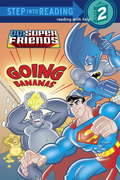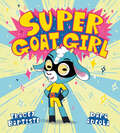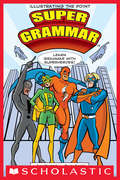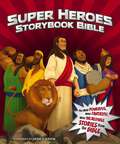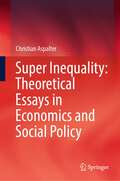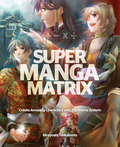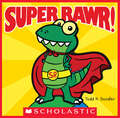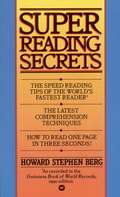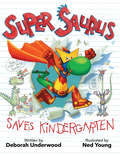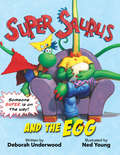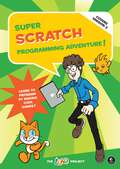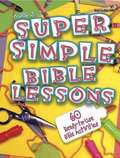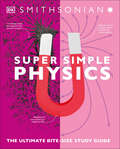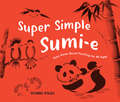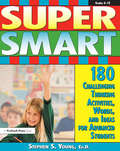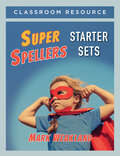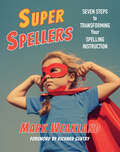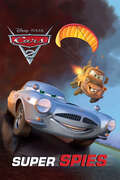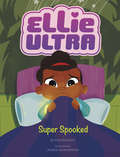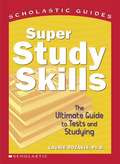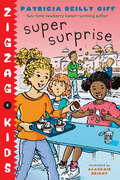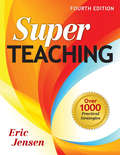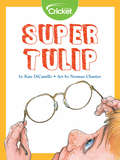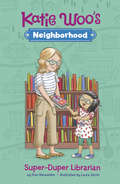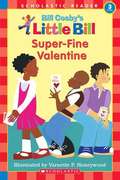- Table View
- List View
Super Friends: Going Bananas (DC Super Friends) (Step into Reading)
by Random House Ben HarperDC Super Friends are big heroes for little boys!Gorilla Grodd is on the loose and causing mayhem everywhere he goes. It's up to Superman, along with Batman and the rest of the Super Friends, to put an end to all the problems this irate primate is causing.
Super Goat Girl
by Tracey BaptisteA graphic picture book about a shy new kid in superhero school, who's not like any of the others, and has to figure out how not to feel so super-strangeOn Super Goat Girl's first day at her new school, she's met with stares. Laserbeam Lass, Robo Kid, and Noodle Boy don't know what to make of her—after all, what kind of a super has no swagger, and not even a cape? At recess, while the others have fun writing with lasers, doing lightning-fast math, and being super stretchy, Super Goat Girl doubts she can measure up. But when an army of evil aliens appears and ties up their teacher, Miss Damsel, it&’s Super Goat Girl to the rescue—the only one who can chomp through the impossibly strong rope. She's sure she'll fit in now, but the other kids just seem confused—is chewing even a superpower? So maybe she's still not the right kind of super. At lunch, she gets another chance to prove herself when a giant gorilla crashes into the cafeteria and her supersonic bleat scares him away. But is being loud a superpower?Then the biggest test comes when the other kids accidentally create a black hole and Miss Damsel is sucked inside. This time when Super Goat Girl helps them save the day with her bravery and quick thinking, they begin to appreciate her. After all, almost every day calls for some superpowers—and they now realize that by sticking together, they&’ll have the best chance of taking on anything that comes their way.
Super Grammar
by Tony Preciado Rhode MontijoThink grammar is difficult? You just need someone to save you from it! The best learning tools for a young mind are word association, visual aids, and superpowers! In SUPER GRAMMAR, all of the major elements of grammar will be personified with superhero or super villain identities. You won't just learn about the part-of-speech called an adverb. Instead you'll meet the vibrant super heroine The Adverb, and you'll learn about her awesome ability to modify verbs and other adverbs. You won't simply be told that you shouldn't use a double negative in a sentence. Instead you'll actually meet the sinister twin brothers, Double Negative, and you'll learn how to avoid being tricked into falling for their double talk. The book's fun, full-color design looks like a mix between a reference book and a comic book. With SUPER GRAMMAR you'll learn to save yourself!
Super Heroes Storybook Bible
by Jean E. SyswerdaThe Super Heroes Storybook Bible is an action-packed Bible for children filled with eye-catching illustrations by Josh O&’Brien and text based on the New International Reader&’s Version (NIrV). Children will be able to read more than forty stories about important and courageous characters of the Bible, such as Noah, Miriam, Moses, Jesus, Mary, and many more, demonstrating the rewards of becoming heroes for God. In addition to inspiring NIrV Bible stories, this storybook Bible will also include call-outs that encourage readers to cultivate important traits like bravery, honesty, and kindness in order to become one of God&’s super heroes in their own life.The cover of this book is printed on metallic paper and shimmer and shines with heroic detail.
Super Inequality: Theoretical Essays in Economics and Social Policy
by Christian AspalterThis book bridges the disciplines of micro-economics and social policy in general, and, in particular, behavioral/explanatory social policy and public choice theory, plus Leibenstein’s X-efficiency theory. Being trained as an economist and social policy scientist, the author leaps out of the comfort zone of most social policy scientists and experts, right into the exciting world of micro-economic theory, and then extending and connecting those theories to explain major social, political and economic conundrums of our time. In doing so, the book offers a new set of theoretical—and practical—explanations derived from the general proposition of micro-economic theory, of how government officers, policymakers, administrators and the people themselves alike are, by and large, motivated in their daily as well as strategic (long-term) decision-making. Using a meta-analytical approach (based on a number of grand theories), this book also explains systemic factors behind human behavior and the thereof resulting shortcomings in lifetime outcomes (health, wealth and happiness of a person) and at the same time societal, policy-making, and economic outcomes on societal level, and in global comparison.The outcomes thereof can be measured exactly (and hence validated), especially through the method of empirical comparative social science/economic research. Here, the author also (but not only) introduces the new method of using Aspalter's Standardized Relative Performance (SRP) Index in measuring exactly complex, aggregate performances of multiple governments, and that at the same time also across the entire world.
Super Manga Matrix: Create Amazing Characters with the Matrix System
by Hiroyoshi TsukamotoWith its stylistic characters and vivid colors, manga has captured the imagination of millions. However, creating it from nothing can be difficult, no matter how inventive an artist is. But now, following the success of Manga Matrix, which taught readers how to create manga characters, Super Manga Matrix will inspire and guide them to create both manga characters and manga stories!Never has character making been approached as methodically as in Super Manga Matrix. Using the unique matrix system, the creation of manga can be plotted and cross-sectioned on a matrix diagram. The result is the remarkable creation of new types of heroes, evil creatures, and multi-formed beasts whose forms and costumes can be designed infinitely. Super Manga Matrix explores a myriad of creatures including angels, demons, dragons, monsters, phantoms, spirits, robots, human, beast combinations, and visionary beings.Regardless of age or skill level, from budding artist to polished professional, anyone with an interest in creating manga will find Super Manga Matrix a valuable resource.Hiroyoshi Tsukamoto is a veteran artist and educator of fine art and graphic design. He has been actively working in the field for over 30 years. Tsukamoto's designs and artworks are numerous, including a mural for the pediatrics ward for the Japan National Cancer Center, character illustration and exhibit design for Nagoya Marine Museum, and character, stage, and costume design for the musical Borocchino!. Tsukamoto is also the author of Manga Matrix and the Japanese bestselling titles Manga Bible and CharaDeza Smash!
Super Rawr!
by Todd H. DoodlerFor career day at school RAWR wants to be a superhero ... SUPER RAWR!"Today is career day at school!I am wearing my superhero cape and belt.Hello, my name is SUPER RAWR!"It's career day at school, and RAWR the T-rex wants to be a superhero. SUPER RAWR to the rescue!SUPER RAWR is a dinosaur who can jump over tall buildings (blocks) and save the day! Preschool, pre-K, and kindergarten children will RAWR with laughter, and career day will never be the same. In the end, RAWR likes just being himself--at least until he goes to sleep and dreams of being an astronaut.Super Rawr! has a cloth cover with a cape and superhero outfit! Young superhero and dinosaur enthusiasts will love RAWR and SUPER RAWR!
Super Reading Secrets
by Howard Stephen BergDevised by the man recorded in Guinness as the world's fastest reader--80 pages per minutes--this is the only program that combines the most up-to-date learning techniques and psychological discoveries with proven speed-reading methods and ancient tools like meditation to significantly improve both reading speed and comprehension.
Super Saurus Saves Kindergarten
by Deborah UnderwoodArnold has a plan. The evil genius Zorgo-disguised as Mr. Zachary-will never stop him. That's because Arnold is . . . SUPER SAURUS! No kindergarten in the universe can hold him.Or can it?
Super Saurus and the Egg (Super Saurus #1)
by Deborah UnderwoodWhen Arnold's parents bring an egg home and tell him he's going to be an older brother, Arnold is not convinced. Arnold knows the egg could be anything. . . maybe even an EGG OF DOOM!If a vampire-saurus flies out of the egg, Super Saurus will be ready! If a planet-crushing robot stomps out of the egg, Super Saurus will be ready! If Maud the Marauder jumps out of the egg, Super Saurus will be ready! But what happens if the Egg of Doom turns out to be Arnold's new little brother or sister?With the same wit, humor and charm that shines in Super Saurus Saves Kindergarten, readers will be captivated by Arnold's super imagination.
Super Scratch Programming Adventure! (Covers Version 2): Learn to Program by Making Cool Games (Covers Version 2)
by The LEAD ProjectScratch is the wildly popular educational programming language used by millions of first-time learners in classrooms and homes worldwide. By dragging together colorful blocks of code, kids can learn computer programming concepts and make cool games and animations. The latest version, Scratch 2, brings the language right into your web browser, with no need to download software.In Super Scratch Programming Adventure!, kids learn programming fundamentals as they make their very own playable video games. They’ll create projects inspired by classic arcade games that can be programmed (and played!) in an afternoon. Patient, step-by-step explanations of the code and fun programming challenges will have kids creating their own games in no time.This full-color comic book makes programming concepts like variables, flow control, and subroutines effortless to absorb. Packed with ideas for games that kids will be proud to show off, Super Scratch Programming Adventure! is the perfect first step for the budding programmer.Now Updated for Scratch 2The free Super Scratch Educator's Guide provides commentary and advice on the book's games suitable for teachers and parents.For Ages 8 and Up
Super Simple Bible Lessons (Ages 3-5)
by Abingdon PressHave you ever needed a Bible lesson QUICK? This resource solves your problem. Super Simple Bible Lessons contains sixty Bible lessons covering both the Old and New Testaments. Each lesson includes a story, a Bible verse, and a super simple craft activity that will reinforce the story. Each craft activity is reproducible. Make as many copies as you need for your class of two or twenty. An easy-to-use index helps you locate specific stories for the children.
Super Simple Physics: The Ultimate Bitesize Study Guide (DK Super Simple)
by DKCrammed with fascinating facts and all the core curriculum topics, this physics book will have you exam-ready in no time!Created in association with the Smithsonian Institution, this completely comprehensive guide makes physics crystal clear. It&’s the perfect support for home and school learning.This super simple science book cuts through the jargon and breaks down the information into easy, manageable chunks. From atoms and states of matter to scalars and vectors, this indispensable guide is packed with everything you need to quickly and easily understand physics.The Ultimate Physics Revision Book Every page is designed to make even the most complex scientific subjects accessible and engaging. Topics are covered in one easy-to-follow single page and fully illustrated to explain the concept - perfect for visual learners. The essential points are in a Key Facts box, which is great for checking back later when revising. Calculations and graphs are set out in simple, logical steps to make the science feel achievable for all students.Whether you&’re a keen physicist or just looking to get an A+,, this accessible science revision guide for children offers clear and concise coverage of all the core physics topics. From dramatic images of planets to bolts of lightning, vivid photography makes it easy for students to relate physics to the world around them.Complete the Series:Alongside SuperSimple: Chemistry, SuperSimple: Biology, and SuperSimple: Maths, these revision guides are part of an exciting new series designed not only to educate, but to inspire.
Super Simple Sumi-e: Easy Asian Brush Painting for All Ages
by Yvonne Palka"The details make this Asian brush painting technique so appealing that both children and adults will be tempted to work at it together, transforming this activity into a true family experience."—Seattle Book ReviewWith a few strokes of brush and ink, you can paint charming animals from pandas to swallows and rabbits to dragons with this introductory book to the traditional art of Asian painting called sumi-e.Creative children and curious adults will have fun learning the magic of sumi-e with the simple techniques illustrated in Super Simple Sumi-e. Learn how to make various sumi-e brush strokes and how to create animals, flowers, and bamboo with this friendly, easy-to-follow guide. Sumi-e means "ink picture" in Japanese. "Sumi" means ink and "e" means painting or picture. Since similar styles of painting with brush and ink are used throughout Asia this style of painting is often referred to as Asian brush painting.
Super Smart: 180 Challenging Thinking Activities, Words, and Ideas for Advanced Students (Grades 4-10)
by Stephen S. YoungGet the minds of bright kids jump-started with these exciting, motivational Super Smart brain challenges. Put the minds of smart kids in overdrive! Filled with 180 "activity-a-day" classroom warm-ups, including new, challenging vocabulary activities and critical thinking activities that push the limits, Super Smart will pique students' curiosity and tickle their funny bone.This unique book, designed to challenge the brightest kids, offers teachers and parents a fun collection of activities—logic puzzles, riddles, optical illusions, math mysteries, and thought provokers.These short, attention-getting mind stretchers serve to grab students' attention and create a frame of mind and an atmosphere of fun, curiosity, and discovery conducive to getting kids off to a good start. There are three hooks for each day: a vocabulary word, a thought for the day, and a critical thinking hook, each designed to get students thinking and into a receptive mindset.Grades 4-10
Super Spellers Starter Sets
by Mark WeaklandWith Super Spellers Starter Sets, you have everything you need to bring to life the wisdom of Super Spellers: Seven Steps to Transforming Your Spelling Instruction. Building on his research-based approach, Mark Weakland provides lesson plans and tools to create spelling centers and teach spelling strategies. This teacher resource provides a wealth of material, all adaptable to match the needs of your students:Seven spelling strategy lessons every student needs to know More than 20 lessons for different grade levels Pointers, differentiated word lists, sorting masters and correlating word ladders Six must-have spelling centers for nurturing independent practice A resource-rich appendix With these resources, your students will notice and remember spelling patterns and words while making connections between spelling and' their' reading and writing lives.
Super Spellers: Seven Steps to Transforming Your Spelling Instruction
by Mark WeaklandMany teachers are frustrated with how spelling is traditionally taught and finding the time to support young spellers with explicit strategy instruction. Author Mark Weakland developed Super Spellers: Seven Steps to Transforming Your Spelling Instruction, an approach to teaching spelling in a way that is research-based and tied to authentic reading and writing. Super Spellers helps teachers understand what their students need through frequent formative assessments. The book focuses on the scope of spelling instruction and teaching spelling strategies to increase students' word-solving skills. Once kids are comfortable and competent spellers they become super readers and writers, too. In addition to step-by-step guidance, each chapter features an If you only have 10 minutes lesson plan segment. The appendix contains word inventories, a sample scope and sequence, examples of spelling list transformation, and word ladder activities.
Super Spies (Disney/Pixar Cars 2)
by RH DisneyAll the world's a racetrack as superstar Lightning McQueen zooms back into action, with his best friend Mater in tow, to take on the globe's fastest and finest in Disney/Pixar Cars 2. This Step 2 film retelling is sure to be a hit with children ages 4 to 6. Step 2 readers use basic vocabulary and short sentences to tell simple stories. For children who recognize familiar words and can sound out new words with help.
Super Spooked (Ellie Ultra)
by Gina BellisarioEllie is invited to a Halloween sleepover at her best friend Hannah's house. She can't wait to have some spooky fun with her friends . . . until the lights go out. Nothing scares Ellie worse than the dark! But when the villainous Fairy Frightmare strikes the sleepover and sprinkles the girls with bad dream dust, trapping them inside their worst nightmares, there are bigger things to worry about. Can Ellie squash her fear and save her friends?
Super Study Skills: The Ultimate Guide to Tests and Studying
by Laurie RozakisFrom the Book jacket: Knowing how to study is important if you want to do your best in school. Super Study Skills: The Ultimate Guide to Tests and Studying has the helpful tips all students need to become more successful. Super Study Skills will show you how to * Study smarter to get the grades you want * Take tests with confidence * Get organized * Use your time more efficiently * Take great notes * Improve your reading comprehension * Reduce test jitters Plus Super Study Skills offers tips for taking specific kinds of tests, including true/false, essay, multiple choice, and more. Whether you are preparing for a standardized test, getting ready for a classroom quiz, or trying to improve your grades, Super Study Skills can help you reach your goals.
Super Surprise
by Patricia Reilly GiffThis week the kids at the Zigzag Afternoon Center are being creative, and trying new things. But that's not so easy for Destiny. All of her ideas turn into disasters--until she finds out what a good poet she is. The sixth book in award-winning author Patricia Reilly Giff's Zigzag Kids series captures all the excitement of new friends and after-school fun.
Super Teaching: Over 1000 Practical Strategies
by Eric P. JensenEmpower students with proven strategies for brain-friendly instruction! This revised fourth edition offers more than 1,000 brain research–based teaching strategies along with reflections, affirmations, sidebars, bulleted lists, quotable quotes, and a wealth of instructional tools. The author shows how to improve instructional effectiveness, plan standards-based lessons, and optimize student learning with practical techniques such as: Matching instruction with learners' developmental stages Responding to unique learning styles with differentiated techniques Using assessment as part of instruction Addressing the learning needs of students in poverty Managing students' emotions with music and energizers Practicing positive teaching mind-sets to enhance student results
Super Tulip
by Kate DiCamilloTulip is not looking forward to being the only kid in her class with glasses, so she decides her glasses give her X-ray vision.
Super-Duper Librarian (Katie Woo's Neighborhood)
by Fran ManushkinA rainy day brings Katie and the rest of the neighborhood to the library. The librarian, Miss Bliss, is the best at finding the perfect book for each reader. But it’s almost time to go, and Katie still doesn’t have a book. What super-duper books will she find?
Super-Fine Valentine (Little Bill Books for Beginning Readers)
by Bill CosbyLittle Bill hates being teased. But now everyone is saying that he's in love! What can he do? Little Bill is lucky. His classmates do kid him after they catch him gazing at Mia, but only a little, and his parents refrain from teasing him when his brother betrays the reason why he's suddenly so eager to go to school. features a letter to parents by child psychiatry specialist Dr. Alvin Poussaint. The story has short chapters so children can read them easily at one sitting. The pictures are described by the proofreader.
